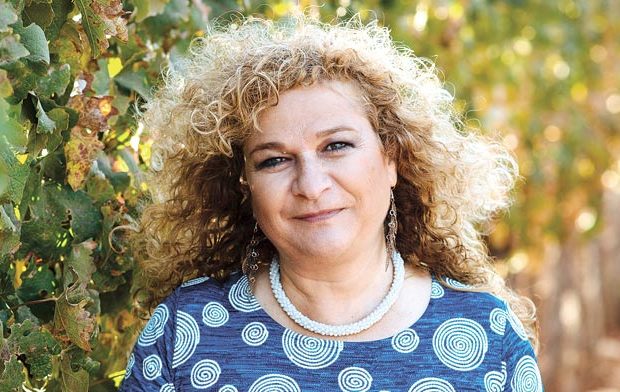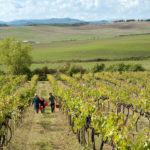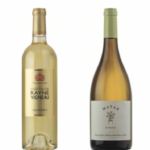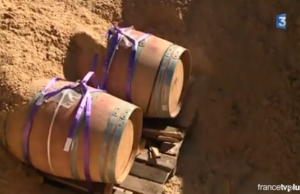Israeli wine: Competition keeps prices down

As part of Israel’s culinary revolution, it appears that the startup up nation has also become the wine nation. New boutique wineries are springing up like mushrooms, and it appears that almost everyone understands wine, and is tossing around terms like vintage, blend, and astringency. In recent years, however, it seems that where wine is concerned, the more we talk about it, the less we drink. BDI figures confirm this: estimated revenue from wine sales in Israel are expected to reach NIS 1.78 billion in 2016, only 2% more than in 2015.
Part of the explanation lies in price erosion caused by growing competition, but this is not the whole story. “More money is passing through the industry, but consumption measured in liters has been stable, combined with the fact that the cost of production has risen with the demand for fine wines,” explains Anat Levy, CEO of Golan Heights Winery and Galil Mountain Winery for the past eight years.
Wine exports have been increasing, coupled with higher production. Production is projected to total 49 million bottles in 2016, compared with 40 million in 2015 and 51 million in 2014. BDI estimates that 70% of these will be sold as cheap wine (up to NIS 40 a bottle), 20% as medium-priced wine (NIS 41-80) and 10% as expensive (NIS 81+).
Golan Heights Winery prefers to keep its distance from the cheap wine category. “The real revolution is the field is the quality revolution,” Levy declares. “The consumers have learned that Shiraz and Syrah are the same thing, for example. The grape varieties in the local industry have changed. At Golan Heights Winery, we have acclimatized varieties such as Pinot noir and Gewurz, together with other varieties we’re developing. Over the past 100 years, Israelis have drunk cheap sweet hangover-inducing wine. Only in recent years have we been exposed to fine wines, and that’s why it’s necessary to acclimatize varieties.”
“Globes”: So we’re willing to pay more than three bottles for NIS 100 bargains?
Levy: “Yes. Awareness has increased, and the second stage is willingness to pay more. Israel is recognized as a surprising wine region, and that reflects the quality revolution that the industry has undergone, and with it a willingness to pay more.”
BDI estimates operating profit in the industry at 8-13% of revenue, and the business risk index for wine manufacturers and importers is lower than the general business risk in Israel. “There are wineries that don’t make any money at all. Fortunately, we’re making a profit, thanks to uncompromising quality and continuous investment in order to provide a solution for the consumers,” Levy says.
What is the average price spent by consumers on a bottle of wine?
“There are supermarket bargains consumers, but consumers buying in wine shops are already spending NIS 50-60, and double that for a bottle of wine on special occasions. We’re not in the cheap category, and that’s part of the secret of survival in this world. Our product composition includes wine from NIS 50 up.”
With the increased awareness, are you selling more?
“We’re selling a little more, but the main increase is in exports. Over the past year, we exported 26% of what we produced. This aspect is growing, and it enables us to relieve the pressure on the local market. Our strong markets are in the US and France, followed by Japan. In monetary terms, Japan is our second largest market, because they buy more expensive wines there.”
As in other industries, China is a big challenge here, too. Global consumption figures show that China will become the world’s largest wine consumer in the next two years, followed by the US, where consumption is also growing. “It’s a very difficult market,” Levy says. “We’re selling to China, but they import wines mostly from France, Australia, and Italy. We have no substantial advantage, and there’s a lot of bureaucracy in exporting to China. We hope we’ll be able to generate a breakthrough.”
“There’s healthy competition here”
Imported wine is granted concessions, while the local industry does not get agricultural subsidies. The result is that imported fine wines are likely to be cheaper than Israeli fine wines, or the same price.
How do you handle the competition?
“Competing against imported wines involves the profit margin. For us, this is a challenge mainly in restaurants and wine shops. We step up our marketing activity, and assume that, like everywhere else in the world, the local consumer prefers local wine. 70-80% prefer buying Israeli wine. As soon as good infrastructure for local production is created, the public recognizes it.”
The local industry, however, is worse off than in other countries. “Farmers and wineries in Israel don’t get the same financing as wineries and vineyards in Europe. In France, wine is a major source of revenue. In Israel, it’s marginal, which makes it difficult to compete against imports and in production. State policy even goes in the opposite direction by opening the gates to imports, including wine, in order to lower prices. This doesn’t exactly encourage people in the sector and agriculture. The wine industry is the beautiful face of Israel; it also helps our image. Wine is frequently used to portray Israel through food and culture, in contrast to what the media says about Israel, and the state still doesn’t take the wine industry very seriously,” Levy complains.
A look at the players in the sector shows that no one manufacturer is dominant. The three biggest players are Carmel, Barkan, and Golan Heights, which aggregately account for 47% of the industry’s revenue. There are also small manufacturers, plus hundreds of wineries, some of them in the boutique category.
Levy does not feel threatened. “It’s healthy competition, because the entire industry’s image has been upgraded. There are boutique wineries, however, whose wine quality is unstable, and that is sometimes harmful, because it doesn’t always provide value for money. In general, though, competition is a health sign that shows healthy growth, even though per capital consumption in liters hasn’t really risen in recent years.”
For Golan Heights Winery, the future generation will bring about the sought for growth. Levy describes her firm’s marketing activity directed at young people. She wants to change the attitude to wine – from a “heavy” drink for parents to something that can be a refreshing substitute for a glass of beer.
“There will be massive growth in consumption, thanks to the 20+ age bracket. Today, they drink beer or vodka, and some of them are exposed to wine at home. My children have grown up on wine. We have raised new generations entering the world, and we’re communicating with them in their media on the social networks, through bloggers, and tasting workshops at the universities, and the response is amazing. We held a party at the winery, and more than 1,000 young people showed up. We founded the Capsula wine club aimed at young people. We’re making contact with their world and tangent worlds, such as fashion events. Wine, which used to be perceived as heavy and elegant, is being associated with young people’s life style and parties.
“We started Galil Mountain Winery, which is marketed in stainless steel barrels with nitrogen processors. These barrels are stationed at 44 sales points, and we’ll reach more of them, including innovative places like pizza parlors. We have a waiting list of businesses that want their own barrels. The price is a factor in accessibility,” Levy says.
In addition to her vision of making wine accessible to young people, it appears that Levy’s real focus is on what she calls “sustainability as a philosophy.” The idea combines society, economics, and the environment, resting on the desire to create a world that can keep itself going in the coming generations. The project includes large-scale recycling (of bottle pallets, for example), a switch to solar energy, the use of barrels that render bottles unnecessary, and environmentally friendly cleaning materials. The growing process is also being changed, in the irrigation aspect, for example, so that some of the grapevines do not receive water, and “teach” the grapevine to sink its roots deeper and look for water sources. This process will receive recognition from an international agency. In the social aspect, Levy lists her firm’s community activities, such as painting kindergartens and immigration center projects.
Does it matter to the consumer whether he buys wine from a sustainable winery?
“It matters to the US consumer. Awareness in Israel is only beginning. We haven’t changed the price; for us, it’s cost cutting.”
“Being in the medium term is difficult”
At a time when Brussels Airlines made headlines for getting rid of (and restoring) a halva snack produced in a Jewish community beyond the Green Line, Golan Heights Winery has receive the compliment of having its wines included in the business class menu of a Japanese airline. Having its production in the Golan Heights is sometimes troublesome for the winery. “We’re also on the menu of Michelin restaurants and prestigious European restaurants, but the problem of boycotts has become a little more difficult this year,” Levy explains. Last year, the German chain KaDeWe removed Israeli products from its shelves, including the winery’s wines. The Israeli wines were put back on the shelves following public pressure, and the chain apologized.
“It was a positive upheaval,” Levy says in retrospect. “The story was very good public relations. The chain was bombarded with Facebook postings, and it put the wine back on the shelves within two days, and apologized. In Germany, which wants to market products, it’s starting to penetrate, and it’s gaining force in Scandinavia, too. This year, we didn’t even bother to compete in two tenders by two major companies, because it was obvious we wouldn’t be selected. As of now, I see no drop in sales, but I don’t know if we’ll make it through such boycotts if they get worse.”
Commenting on the indirect route, Levy says, “In Italy, our wines are distributed by the Gaja winery, through which we enter expensive restaurants. Demand is so high that the winery gets only 50% of what it asks for. We can’t supply the amounts they ask for.”
There are also boycotts by Israelis.
“Yes, it’s not much fun, but fortunately, it doesn’t really affect sales. Golan Heights is the name of the winery, and it’s our identity. All the vineyards except for one are located on the Golan Heights.”
Golan Heights Winery recently signed a distribution agreement with Shaked, an importer of overseas wine that markets the Recanati, Tzora, and other wineries, in the framework of founding a sales and distribution company. This company, Wine Palace, is designed to stave off competition from Coca Cola, which owns the Tabor Winery, while Tempo owns the Barkan/Segal winery.
“The goal is to streamline the logistics aspects,” Levy says. “As an importer, Shaked is ostensibly our competitor, but together we reach more sales points, and with a larger basket. Over the past decade, large players from the global beverages industry have entered the industry, which has become part of the basket of products, together with soft drinks and alcoholic beverages. Some of them also deal in coffee. Such measures are enabling the industry to change its structure, emerge from wine sector, and expand.”
Are the big ones trampling the small ones, like they are doing in other food sectors?
“Our market share is just as good as that of the big players. We were bigger in the past, but then the market was smaller. Our market share may have shrunk, but our turnover is bigger. The market has changed. Some players have closed down. There are wineries that have sold holdings to other parties. Small wineries are growing, and there are also wineries that are not surviving. We wanted to be the biggest winery in the north, and that’s why we went to the Golan Heights and the Upper Galilee.”
Are you considering expansion to other areas in Israel, or buying a small winery?
“We’re thinking about it. We’re getting offers, and everything is being considered on its merits.”
Since 2010, Golan Heights Winery has been a partner in Golan Brewery, together with the Bazelet beer brand. Will you consider expanding into food categories or other beverages?
“No. We believe in focusing and continuing in what we’re good at.”
From time to time, the name of a winery is mentioned as being up for sale. The market is saturated with players. Which way do you think it will go?
“It’s an interesting market with growth potential. One or two of the group of medium-sized wineries will fall. You have to grab a position, because sometimes it’s a problem being in the intermediate range. It’s better to go one way or the other – to be large or small. There’s more risk being in the middle.”
Published by Globes [online], Israel business news – www.globes-online.com – on October 30, 2016
© Copyright of Globes Publisher Itonut (1983) Ltd. 2016
Click here to view original web page at www.globes.co.il


























